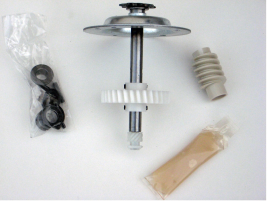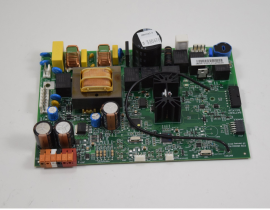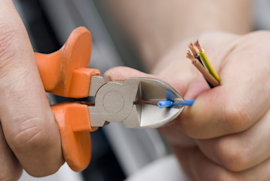- Kenmore refrigerator water filters
- Whirlpool refrigerator water filters
- Samsung refrigerator water filters
- GE refrigerator water filters
- LG refrigerator water filters
- Frigidaire refrigerator water filters
- KitchenAid refrigerator water filters
- Maytag refrigerator water filters
- Kenmore Elite refrigerator water filters
- Estate refrigerator water filters
- GE Profile refrigerator water filters
- Amana refrigerator water filters
- Bosch refrigerator water filters
- Dacor refrigerator water filters
- Electrolux refrigerator water filters
How to make force adjustments if a garage door won't open or close video


If your garage door freezes on the way up or if it stops and reverses directions on the way down, you may need to increase the force adjustments on your garage door opener. This video from Sears PartsDirect shows how to check the garage door for smooth travel, adjust force settings and test the new settings to make sure the door closes safely.
For more troubleshooting tips, repair guides, error codes and answers to frequently asked questions, see our DIY garage door opener repair page.
Rule out safety sensor problem
Hi, this is Wayne from Sears PartsDirect. Today we're going to talk about what to do when your garage door won't open or close because the force setting is too low. Inadequate up force can cause the door to stop on its way up. If you set the downforce too low, the door will stop on its way down, then reverse and open back up.
Now, if the opener lights are blinking, you likely have a safety sensor problem. The lights don't blink when inadequate force causes a door reversal. Here's a link to a video that covers troubleshooting problems with the safety sensors.
Check trolley travel on rails
Before we adjust the force, let’s check the door for smooth travel. Sometimes, bent or damaged tracks can cause similar issues to incorrect force settings. Pull the emergency release rope to disconnect the trolley from the door. Manually lower and raise the door to make sure it goes up and down easily. If the door stops or gets stuck on the tracks, check to see if the tracks are bent or damaged. Fix any problems you find or you can have a Sears technician complete the repairs.
If the door opens and closes easily, reconnect the door to the trolley and increase the downforce by turning the adjustment screw clockwise. Turn the screw a quarter-turn at a time and retest after each adjustment until the door closes completely.
Setting downforce
Once the door is closing all the way, make sure that the downforce is not set too high. Excessive downforce is dangerous and can cause property damage or injury to anything caught in the path of door. Close the door with the opener and carefully grab it with your hand when the door is halfway down to make sure that the downforce isn't excessive.
If you can stop the door using your hand, then no further adjustment is necessary. If you’re unable to stop the door with your hand, reduce the downforce in small increments. Make adjustments until the door closes completely on its own but will still stop if you catch it halfway down.
Setting up force
Next, let’s look at up force adjustment. If your door stops without opening completely, then you may need to increase the up force on the garage door opener. You can increase the up force by turning the adjustment screw clockwise. Turn the screw a quarter-turn at a time and retest after each adjustment until the door opens completely. Just like with downforce, be sure to test the up force setting for safety.
Stop the door with your hand when it’s halfway up to make sure that up force isn't excessive. Continue making small adjustments until the door opens completely on its own and you can stop the door by hand halfway up its travel. If you don't see force adjustment screws on the motor unit, then your garage door opener may adjust force automatically. Check your owner's manual for more information.
I hope that this video helped you out. You can check out more garage door opener videos here on the Sears PartsDirect YouTube channel. Subscribe and we’ll let you know when we post new videos.
Most common symptoms to help you fix your garage door openers
Choose a symptom to see related garage door opener repairs.
Main causes: garage door opener misaligned, travel limits need adjustment, bad travel limit switches, faulty logic contr…
Main causes: garage door locked, damaged garage door tracks, up-force setting needs adjustment, RPM sensor failure, bad …
Main causes: safety sensor beams blocked, safety sensors not aligned, downforce setting needs adjustment, damaged garage…
Things to do: check garage door travel, tighten brackets and fasteners, test safety sensors, check travel limits and for…
Main causes: radio interference, weak remote batteries, sunlight interference with safety sensor beams, safety sensors n…
Main causes: faulty logic control board, bad RPM sensor, broken gears in the drive system, bad drive motor…
Main causes: neighbor's remote programmed at the same time as yours, faulty wall control wiring, bad wall control unit…
Main causes: loose fasteners, broken brackets, need preventive maintenance, worn drive gears, loose or worn belt, loose …
Most common repair guides to help fix your garage door openers
These step-by-step repair guides will help you safely fix what’s broken on your garage door opener.

How to replace a chain-drive garage door opener gear and sprocket assembly
Learn how to replace the gear and sprocket assembly on your garage door opener if the drive motor runs but the door won'…
Repair difficulty
Time required
60 minutes or less

How to replace a garage door opener logic board
The logic board is the brains of the garage door opener. If the remote doesn't work or the door doesn't open and close p…
Repair difficulty
Time required
60 minutes or less

How to replace a garage door opener drive chain and cable assembly
If your garage door won’t move, the chain and cable assembly on your garage door opener could be broken. Follow these st…
Repair difficulty
Time required
60 minutes or less
Effective articles & videos to help repair your garage door openers
Use the advice and tips in these articles and videos to get the most out of your garage door opener.

Learn about all the convenient features on our Sears PartsDirect website that make your parts purchases easier.…

Get answers to frequently asked questions about Sears and Sears PartsDirect.…

Learn how to repair broken, frayed or damaged wires in your appliances.…